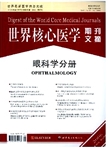细胞因子基因多态性与英国特发性中间葡萄膜炎患者预后有无相关性
Are cytokine gene polymorphisms associated with outcome in patients with idiopathic intermediate uveitis in the United Kingdom作者机构:Academic Unit of Ophthalmology Division or Immunity and Infection University of Birmingham Birmingham B15 2TT United Kingdom Dr.
出 版 物:《世界核心医学期刊文摘(眼科学分册)》 (Digest of the World Core Medical Journals:Ophthalmology)
年 卷 期:2005年第1卷第11期
页 面:29-30页
学科分类:1002[医学-临床医学] 100212[医学-眼科学] 10[医学]
主 题:中间葡萄膜炎 细胞因子 基因多态性 眼部炎症 单体型分析 眼部疾病 眼部征象 等位基因频率 双眼视力 疾病预后
摘 要:Background/aim: Competing levels of cytokines, either locally within the eye o r systemically, may influence the eventual out-come of ocular inflammation. Pol ymorphism in the promoter part of the genes controlling cytokine production may result in either higher or lower production of the relevant cytokine to a given stimulus. The authors hypothesised that such polymorphisms may relate to visual outcome in patients with idiopathic intermediate uveitis. Methods: DNA was obtai ned from 125 patients with idiopathic intermediate uveitis and analysed for the interleukin 10 IL-10-1082G/Aand IL-10-819C/T, and interferon γIFNγ874T/A g ene polymorphisms. Associations with disease were calculated by both allelic fre quency and haplotype analysis, and associations between ocular disease outcomes and the presence of polymorphismswere identified. A bad outcome was defined as l oss of vision 6/12 Snellen in both eyes at 5 years from presentation when the e yes were quiet. Results: An initial screen showed that the 874T allele of the IF Nγgene was more prevalent in patients than controls (χ2=7.9; p=0.004 OR 1.7; 9 5%CI 1.2 to 2.6 (Pc=0.02), whereas the IL-10-1082/-819 AT haplotype of the i nterleukin 10 (IL-10) gene was not. Analysis of disease outcome showed an assoc iation between IL-10-1082 AA homozygosity and bad outcome (χ2 =13; p=0.0003). Moreover, the two cytokine polymorphisms taken together showed that up to 75%o f patients with a poor visual outcome had the combined IFNγ874TA or TT genotype together with the IL-10-1082AA genotype (χ2=13.2 p=0.0008 OR 6.4; 95%CI 1.8 5 to 23.6 Pc=0.1). Conclusion: These results show that disease outcome in interm ediate uveitis may be partly determined by a complex interplay between cytokine genes and these results may have implications for future treatment with biologic al agents that target these cytokines.



